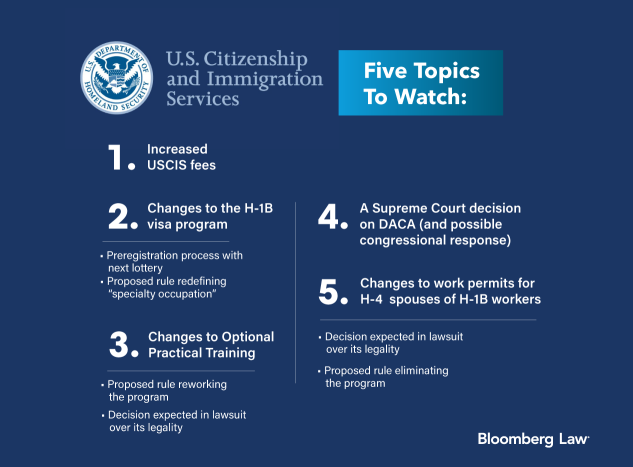The past year has arguably been the Trump administration’s most successful one in its quest to restrict asylum at the U.S.-Mexico border, overhaul the nation’s legal immigration system, crack down on undocumented immigrants, alter America’s status as a safe haven for refugees and challenge decades of bipartisan consensus that robust immigration is key to America’s economic and social prosperity.
The 2020 promises to be a big year for employment-related immigration developments.
Here are the top five to watch.

USCIS Fees
Applying for a visa will get a lot more expensive. That’s if the final version of U.S. Citizenship and Immigration Services’ new fee schedule looks anything like its proposal—and it likely will. And that fee increase will be especially acute for employers of temporary foreign workers.
The USCIS also is proposing to increase the fee for named workers on H-2A agricultural guest worker visas and H-2B nonagricultural, seasonal guest worker visas while limiting the number of named workers who can be listed on each petition. That means employers seeking large numbers of guest workers will be on the hook for potentially hundreds of thousands of dollars each season.
The proposed rule is a sweeping attack on the United States immigration and naturalization system designed to limit immigration, asylum, and naturalization, with a disproportionate impact on communities of color and non-wealthy immigrants. The proposal includes a plan to transfer over $100 million of USCIS funds to Immigration and Customs Enforcement (ICE), the agency responsible for enforcement.
H-1B Changes
Electronic preregistration for the H-1B lottery becomes official March 1, 2020. Authorized by a January 2019 regulation, the new process will allow employers to enter the lottery for the 85,000 visas that become available Oct. 1, 2020, without having to prepare a full petition and supporting documentation.
Preregistration has the potential to streamline the H-1B application process, but also could cause problems for smaller employers trying to compete for the visas.
Also expect to see a new proposed rule from the USCIS that would redefine an H-1B “specialty occupation” to restrict eligibility to the “best and brightest” applicants. The proposal likely will reflect how the agency already is treating H-1B petitions, but codifying the practice would make it more difficult for businesses to challenge visa denials in court.
DACA Decision
The U.S. Supreme Court likely will rule in June on whether the Trump administration legally ended the Deferred Action for Childhood Arrivals program, which provides deportation protections and work permits to young, undocumented immigrants who came to the U.S. as children.
The justices’ reaction to oral arguments Nov. 12 appears to indicate that the court will back the administration’s curtailment of the seven-year program.
One report by pro-immigration groups estimated that ending DACA will result in an average of 30,000 DACA recipients losing their jobs every month. Another report concluded that removing DACA workers from the economy would cause a $460.3 billion drop in the national gross domestic product over the next decade.
The question remains whether Congress would be willing to pass legislation providing legal status to DACA recipients so close to the election. The House passed such a bill in June, but the Senate hasn’t made any move to take it up.
Optional Practical Training
Optional practical training, which allows foreign graduates of U.S. colleges and universities to work in the U.S., could see big changes next year.
A federal judge in Washington has indicated a willingness to entertain a lawsuit by a group of U.S.-born tech workers who say OPT is illegal and harms their job prospects. The potential for the case to upend OPT recently prompted a wave of amicus briefs.
“Without OPT and STEM OPT, employers would suddenly find fewer STEM-educated persons to take positions in the United States for jobs that cannot be filled with native employees alone,” according to one brief filed by 52 businesses and 11 industry associations.
Immigration and Customs Enforcement, which manages OPT, also has revived its plan to overhaul the regulations governing the program. That change, combined with another proposal to limit how long international students can remain in the U.S., could upend how the program operates in the future—if the courts allow it to continue.
H-4 Work Permits
A longtime Trump administration promise to rescind a program providing work permits to certain H-4 spouses of H-1B workers likely will come to fruition in 2020.
A Homeland Security Department proposal has been under review at the White House Office of Management and Budget since February 2018. The agency now anticipates a spring 2020 release for public comment, which would mean a summer or early fall implementation of the final regulation.
A lawsuit against the program brought by U.S.-born tech workers also recently gained traction when a federal appeals court in Washington said the workers showed that it’s causing them to face increased job competition. Now back with the federal district court, the case could result in a finding next year that the program is illegal.
That would put more than 120,000 H-4 spouses, mostly women from India, out of work.
By Laura D. Francis Bloomberg Law.
By Camilo Moyntoya-Galvez Dec. 31, 2019/ 6:59 AM/ CBS News
